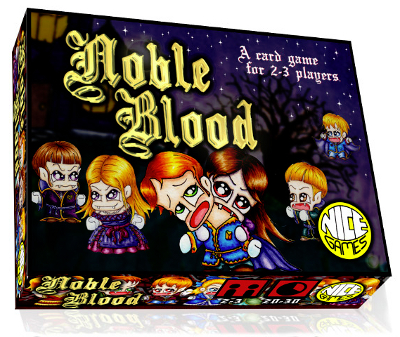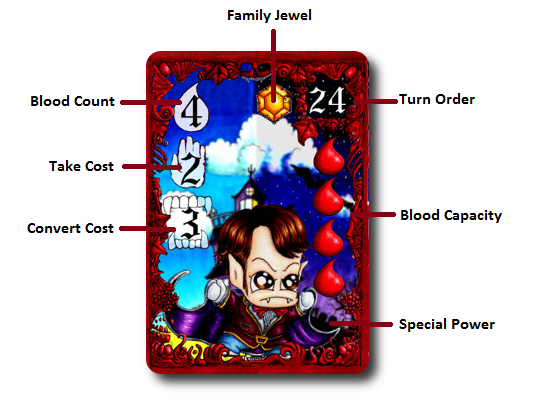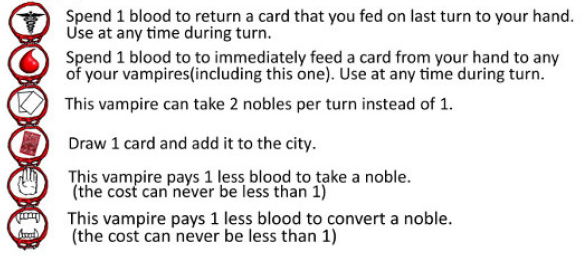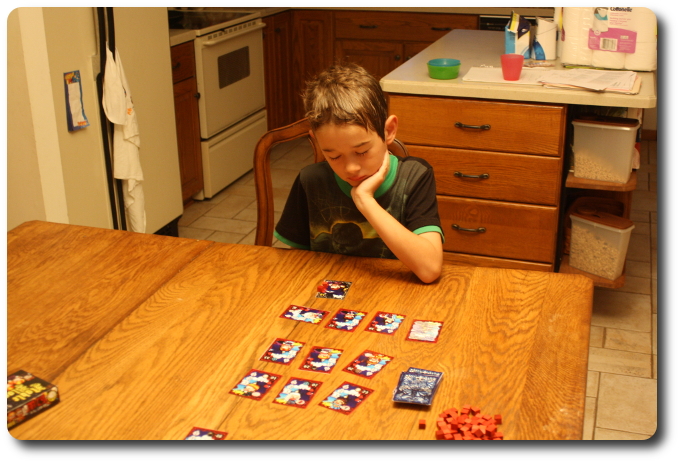Please Take Note: This is a review of the game’s final prototype. The art, game bits, and the rules discussed are all subject to change. The game is being reviewed on the components and the rules provided with the understanding that “what you see is not what you might get” when the game is published. If you like what you read and want to learn more, we encourage you to visit the game’s website or visit the Kickstarter campaign. Now that we have all that disclaimer junk out of the way, on with the review!

The Basics:
- For ages 8 and up (publisher suggests 13+)
- For 2 to 3 players
- Approximately 30 minutes to complete
Geek Skills:
- Counting & Math
- Logical & Critical Decision Making
- Pattern/Color Matching
- Strategy & Tactics
- Hand/Resource Management
Learning Curve:
- Child – Easy
- Adult – Easy
Theme & Narrative:
- Become the strongest and most influential Vampire Lord in the city
Endorsements:
- Gamer Geek approved!
- Parent Geek approved!
- Child Geek approved!
Overview
The great City by the river sleeps as the stars above it twinkle like a thousand torches. But all is not quiet. Moving from shadow to shadow are the undead and they are hungry. These vampires search for blood to feed upon to sustain their existence. The humans are powerless to fight off the hungry vampires, but the great City only has so many necks to bite. The Vampire Lords must fiercely compete for the one resource that matters most: noble blood.
Noble Blood, designed by Marc Distefano and to be published by Nice Games, will reportedly be comprised of 50 Noble cards, 4 Vampire Lord cards, 3 Player Aid cards, and 60 Blood cubes. As this is a review of a prepublished game, we will not comment on the game component quality. The illustrations for the game, however, deserve a bit of a nod. For a vampire themed game, the undead are wonderfully cute and disarming. The art direction is using the Chibi illustration style to portray the Vampire Lords and their converted Noble vampire minions. The end result is something oddly adorable, in an undead kind of way.
All About Very Cute Vampires and Their Nobles
Every player starts with a Vampire Lord, which is little more than a feeding machine. “The blood is life”, or so the vampires are fond of saying, but it’s also power. Without blood, a vampire will turn to dust, but through blood, endless life and the ability to control humans is possible.

In the nearby City, the noble families rule by day, but hide in terror by night. The Nobles represent the powerful humans who rule, but are also the preferred feeding stock of the Vampire Lords. Once a Noble is under the control of a Vampire Lord, they are either cattle or slave. Nobles both sustain and further the Vampire Lords’ goals, making them a very useful tool and resource.
The Noble cards have information on both the right and left side of the card’s face, where the Vampire Lord card only uses the right side. When the Noble is still a human, only the left side of the card’s face is used (Blood Count, Take Cost, and Convert Cost values). Once the Vampire Lord decides that the Noble is better utilized as a vampire underling, they are turned and only the right side is used (Turn Order, Blood Capacity, and Special Power). At the top of the Noble cards is a Family Jewel. This represents one of the five possible great houses the noble is a member of and is used during endgame scoring.

The majority of vampires have special powers. If a Noble card has a Special Power, it is not available for use until the Noble is converted into a vampire. Vampiric Special Powers can only be used on the card’s turn (explained below). The available powers are summarized here.

Game Set Up
To set up the game, first separate the Noble cards from the 4 Vampire Lord cards. The Vampire Lord and Noble cards have different colored card backings making this an easy exercise.
Second, shuffle the 4 Vampire Lord cards and deal 1 Vampire Lord card to each player or have each player select a Vampire Lord card of their choice. Note that the Vampire Lord cards provide different powers and other strengths. No one Vampire Lord has a clear advantage over the other, but each Vampire Lord card does suggest a slightly different tactical approach to the game for the first couple of rounds. Any shortcoming a player might perceive in their Vampire Lord can be addressed by converting Nobles to vampire minions. Players should place their Vampire Lord card in front of them, face-up. Any unused Vampire Lord cards are set to the side and are out for the duration of the game.
Third, shuffle the Noble cards and then draw 6 Noble cards for a 2-player game or 8 Noble cards for a 3-player game. Any Noble cards drawn that have a Take Cost value of “3” should be placed at the bottom of the Noble deck and a new card drawn. The Noble cards are placed face-up in two rows with each row having an equal number of cards each. Shuffle the remaining Noble cards again if any Take Cost “3” values were placed on the bottom. Then place the Noble deck face-down next to the face-up Noble cards. This area is referred to as the “City”.
Fourth, hand to each player 2 Blood cubes, placing the remaining Blood cubes by the City and within easy reach of all the players. This is the players’ Blood cube pool. Players should now place the 2 Blood cubes on any open Blood Capacity icons found on their Vampire Lord card.
That’s it for game set up! Let’s see who the greatest Vampire Lord is!
They Only Come Out at Night
Noble Blood is played in rounds with no set number of rounds in a single game. Players will be taking multiple turns per round. Each round has three phases and these phases are further broken down into multiple actions. A typical game round is summarized here.
A quick note on turn order. A player’s turn and what cards they can use is defined by each card’s Turn Order value. The card (be it Vampire Lord or converted Noble) with the lowest Turn Order value will always go first, followed by the next lowest and so on until all the cards have had a chance to be used in the current phase. This means a player could collect Noble cards to dominate each phase of the game by always selecting cards with the lowest Turn Order value. Doing so has some slight disadvantages, but is an excellent example of one of the many subtle tactics and strategies the players must discover and then utilize to win.
Phase 1: Repopulate City
At the beginning of each round, the City is resupplied with Nobles. During the first round of the game, this phase is skipped. When a Noble is removed from the City during phase 2, the space it occupied remains vacant for the round. For each vacant space, 1 Noble card is drawn from the Noble draw deck and placed face-up in the vacant space. This is done until the total number of Noble cards is equal to the number of Noble cards dealt during the game set up (6 in a 2-player game or 8 in a 3-player game).
Phase 2: Actions
During this phase, each vampire card will have a turn (in Turn Order value sequence) and will allow the player to take up to 2 possible actions. If the vampire card has a Special Power, it can be used only on the card’s turn.
- Take Noble: A player can take 1 Noble card per vampire card’s turn from the City area. The available number of Nobles can quickly dwindle if players are particularly aggressive about capturing Nobles for their feeding stock. A Noble card is taken into the player’s hand and there it will remain until used to feed upon or converted into a vampire. The cost to take a Noble card is defined by the Noble card’s Take Cost value. The number represents how many Blood cubes the current vampire card in play must spend in order to take the Noble card. If the vampire has enough Blood cubes, they are taken off the vampire card and placed in the Blood cube pool. The Noble card is then removed from the City area and taken by the player. This action is optional.
- Convert Noble: A player can convert 1 Noble per vampire card’s turn from human to vampire. The player places a Noble card from their hand next to any other vampire cards they own. They then pay the Covert Cost value noted on the Noble card in Blood cubes, placing them back in the Blood cube pool. The Blood cubes are taken from the current vampire card who is taking the action (i.e. biting the noble). The newly born vampire does not start with any Blood cubes and cannot take any actions until fed. When placing new vampires, lay them down either to the right or to the left of the other vampire cards so the Turn Order values on each card ascend (get bigger) from left to right. This will make it easy to quickly tell who’s turn it is and which vampire card is currently taking an action during the round. This action is optional.
- Pass: A player can decide to simply skip their turn and not take any actions during this phase with their vampire cards.
After all the vampire cards have had a chance to take 1 Noble and convert 1 Noble, the phase ends.
Phase 3: Feeding
The third phase should be done one player at a time, but the order in which the players complete this phase is up to them.
One at a time, each player will play as many Noble cards from their hand as needed to feed their vampires. Each Noble card has a Blood Count value. This represents how many Blood cubes the player can take from the Blood cube pool and place on one vampire card. Nobles, once drained, will recover and be able to provide more blood, but they cannot be used again for an entire round. This makes them an unlimited resource, but one that must be managed carefully.
Each player should complete the following actions in the sequential order summarized here.
- Rotate previously fed upon Nobles from the last round. Turn them, flip them over, or simply set them aside. These Nobles will be taken back into the player’s hand at the end of the phase, but are out of play for the moment.
- Play as many Noble cards as necessary to feed all the vampires. The number of Blood cubes a Noble provides is identified by its Blood Count value. Nobles fed upon are played to the player’s left. Each Noble can feed 1 vampire, but a vampire can feed upon multiple Nobles. The blood extracted from a single Noble cannot be divided among multiple vampires and a single vampire can only hold a maximum number of Blood cubes equal to the vampire’s Blood Capacity value. This means that if a Noble provides more blood than the vampire can currently hold, the excess is placed back into the Blood cube pool. A vampire must have at least 1 Blood cube on it to be considered “fed”.
- Any vampire cards that do not have at least 1 Blood cube starve and turn to dust. These vampire cards are removed for the duration of the game.
- The player takes all the previously fed upon Nobles from the last round (turned over or flipped or set aside per the instructions of the first action of this phase) and places them back into their hand. All the Nobles played for this round remain on the table.
After each player has completed the above sequential actions for this phase, the round ends and a new round begins starting with phase 1 described above.
Breaking Dawn
The game can end one of four ways.
- When a player has 7 or more vampire minions in play (not including their Vampire Lord card)
- When a player has 5 or more vampire minions that all have the same Family Jewel
- The last card in the Noble deck is used to repopulate the City
- All but one player has vampires left because the player’s opponents let their vampires starve
When any of the above conditions have been met, the current round is completed per the phases noted above. Players then count how many points they have scored during the game. If only one player is left holding vampires, they win by default and determining the final score is unnecessary.
First, players count the points derived from the power of vampire blood and their total vampire strength.
- 1 point per Blood cube on each vampire the player controls
- 2 points per Noble converted to a vampire
Second, players count the points derived from their overall influence over the City through the noble houses. The player is given two options, but only one of the two can be used.
- 3 points per Family Jewel – only one Family Jewel type can be scored but which type is up to the player OR…
- 13 points for having at least 1 Family Jewel of each type (there are 5 Family Jewel types in total)
Once all the points are determined and the final score tallied for each player, the player with the highest score wins the game.
To learn more about Noble Blood, visit the game’s website or visit the Kickstarter campaign.
Prediction
Usually, the Parent Geeks squirm a bit when I suggest we put a game about the undead in front of their Child Geeks. Lots of games have fantastic but gruesome illustrations of the “things that go bump in the night” that could give the Child Geeks nightmares. I don’t think the illustrations in Noble Blood will cause anything more than tooth decay due to the little vampires looking so cute and sweet. This means we’ll be able to get this game in front of our younger players without fear of causing psychological damage.
The game’s theme and ease of play will appeal to the Child Geeks, and the game has more than enough depth for the Parent Geeks, too. I predict both the Child Geeks and the Parent Geeks will give the game their approval after they have completed a few playing sessions. For the elitists, I predict they will see it as a light resource management game. There is certainly need for strategy and tactics, but the game’s overall depth is not so deep as to suggest that Noble Blood could be anything more than a game filler to a Gamer Geek.
Teaching Noble Blood is very easy. Focus on the sequence of play, the special powers, and what actions are available during each round. This shouldn’t be time-consuming and the game slowly ramps up in difficulty, which will allow even non-gamers to “learn as they go” with ease. I highly suggest you emphasis the importance of keeping vampires fed and not spreading resources thinly. Failure to feed a vampire will result in a pile of dust. And since Noble Blood doesn’t require any reading and all the math is exceedingly simple, younger Child Geeks should be able to play this game without issue. Of course, as the game progresses, the choices the player will need to make become more and more difficult. What will cause the younger Child Geeks to lose their cool is the eventual crisis created from poor resource management.
After teaching the game to my 8 and 6-year-old, I asked them their thoughts on Noble Blood so far.
“Looks to be an easy and fast resource game. I love that it’s about vampires!” ~ Liam (age 8)
“These vampires aren’t scary at all. They look like babies.” ~ Nyhus (age 6)
Both of my little geeks are ready to go! Time to sink our fangs into the game!
Final Word
The older Child Geeks did very well with Noble Blood, demonstrating excellent resource management and logical card plays. Meaningful tactics and strategy also became apparent, but only after several games had been played. Most of the time, and early on in the games, the Child Geeks appeared to be grabbing what Nobles they could afford and going out of their way to feed their vampires. Not a bad way to play the game, but it lacked direction. All this changed when they suddenly “got it” and started to focus on specific Noble cards and using the vampire powers. The younger Child Geeks floundered right from the start and never demonstrated a solid grasp of maintaining good resource management. My 6-year-old did very well until he had 4 or more vampires. After that, he had a difficult time managing his Nobles and feeding his undead minions. He still enjoyed it, but the frustration was visible on his face. After all the games were done and the testing was over, the Child Geeks voted to approve Noble Blood, finding it to be a fast and fun game of creating vampire armies! The level of enjoyment was not universal across the group, but none of the Child Geeks suggested they thought the game was bad.

My little geek contemplates how best to drain the blood from the City
The Parent Geeks were strangely in love with this game. I think it had to do with the illustrations. Regardless of what it might have been, the Parent Geek demonstrated a very clear understanding of the game and excellent resource management skills. Even the non-gamers understood the importance of keeping vampires fed and happy. The Parent Geeks also demonstrated a clear understanding of the importance of diversifying their vampires and collecting Family Jewels. The final scores were always high and every game with the Parent Geeks was competitive. The games were less so when they played it with their Child Geeks, but the games were always fun. According to one Parent Geek, “This is a fast, easy to understand, easy to play, and fun card game. I really like it.” All the Parent Geeks agreed and gave the game their approval.
The Gamer Geeks appreciated the game from the very start. They liked how much control they were given, the way the turn order sequence changed each round, and how much strategy and tactics were necessary to be competitive. According to one Gamer Geek, “I am surprised how much I need to think about my moves. I thought this game would be really light, but it’s making me pause and consider what I should do on my turns.” The game was still found to be light, but the game’s level of depth kept the Gamer Geeks engaged throughout the entire playing session. Another Gamer Geek said, “This game is doing nothing new or different, but it works and works well. I think it would be an excellent game to introduce to new players and I could see myself playing this game while waiting for others.” The same sentiment was shared by all the Gamer Geeks who found Noble Blood to be an enjoyable game full of fun choices and surprising depth. They approve Noble Blood without hesitation.
I really enjoyed Noble Blood and think it would be an excellent addition to any family’s or gamer’s collection. It’s light, but deep. It’s easy to play, but demands players use strategy and tactics if they want to be competitive. It’s a game that can be easily taught and then played again and again at the gaming table without going stale.
Well, almost.
Towards the end of the game, you might see some players sour. As the game progresses, each round takes longer and might start to feel repetitive. The more vampires in play, the more actions available to the player. A single round of game play towards the end of the playing session will be significantly longer than the first couple of rounds, but we’re only talking by several minutes. There’s a strange trade-off at work here. At first, players will be playing quickly and choices will seem automatic. As the game progresses, the rounds will slow down and the choices will become harder, but they are always the same choices. Timing becomes very important. If you miss your window of opportunity, the rest of the round can feel wasted. Especially if you spend your turns simply passing.
I would recommend Noble Blood to any player who likes a good card game where resource management is a major aspect of the game play. The vampire theme feels somewhat pasted on, but it works very well within the game’s narrative of blood and eternal servitude. You’d think that would make this a dark and brooding game playing experience, but the game is lighthearted from the start. This is a fast and fun to play game which makes it easy to enjoy and to get out on your gaming table. I’ll be the first to say that Noble Blood isn’t breaking new ground or moving the game designing world in a bold new direction, but the game is solid, well designed, and very well thought-out. That’s all I want out of my games and Noble Blood delivers. Do check it out when time allows.
This is a paid for review of the game’s final prototype. Although our time and focus was financially compensated, our words are our own. We’d need at least 10 bazillion dollars before we started saying what other people wanted. Such is the statuesque and legendary integrity of Father Geek which cannot be bought except by those who own their own private islands and small countries.



